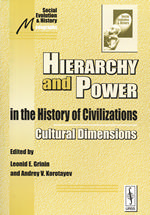
|
Hierarchy and Power in the History of Civilizations:Cultural DimensionsMoscow: KRASAND, 2009. - 216 p.
Edited by Leonid E. Grinin and Andrey V. Korotayev
ISBN 978-5-396-00010-0 |
The human history has evidenced various systems of hierarchy and power in different spheres of social life. The relations of hierarchy and power are relevant for every sphere as they penetrate the whole life of a society and represent a sort of framework for an individual's activity. The cultural sphere (in the wide sense of the word) is not an exception, although, of course, it has great peculiarities in the manifestation of power-hierarchical relations. The relations here are usually informal and more often connected with traditions than with norms, there are much less power structures that have the legal right for coercion. The book consists of two main parts. The papers included in the first section discuss the dynamics and potentials of newly emerging socio-cultural network structures and the ways in which they reconceptualize socio-cultural organization through innovative forms of spatial practice. The second section is dedicated to the study of new models of communication whose influence overcomes states' borders and which have a great potential and capabilities for destroying the basis and cultural values of the society.
Contents
Contents
Introduction
List of Contributors
Part I. Networked Cultures: Negotiating Cultural Differences in Contested Spaces
1 ‘Ordinary Young Hooligans’ or Moscow Geographies of Fear: Spatial Practices in and around the Peoples' Friendship University of Russia
Cordula Gdaniec
2 Crossing the Mediterranean: Networked Agencies in Art and Culture
Peter Mörtenböck
Plan and Conflict Istanbul at the Threshold
Helge Mooshammer
The Greenland Problem. Digressions of Appropriation
Andreas Kofler
5 Modern Tendencies of a Permanent Partner's Choice among the African Students and their Attitudes to Procreation and Multi-child Families
Marina L. Butovskaya, Darya A. Dronova, and Eginald Mihandzho
Part II. Changing in Modern Mass Media and Public Sphere
6 News Factors in Global Press Coverage: The Flow of News in the Global Press
Annekaryn Tiele and Helmut Scherer
7 A Little Bit of Everything – An Analysis of Web-based European Political Communication
Gabriella Szabó
8 Internet and the Public Sphere: The Habermasian Ideal
Model and the Reality of the Runet
Anna D. Trakhtenberg
9 Expanding the Zones of Free Public Discourse in Post-apartheid South Africa, 1990–2005
Johannes D. Froneman
10 Media, Soviet Habits, and Culture Competing for Supremacy over the Public Sphere
Lucie Hribal
11 Mass Media, NGO and Policy: the Case of Post-Soviet ‘Revolutions’
André Bourgeot
12 Vertical Europeanisation of the Online Public Dialogue: EU Public Communication Policy and Online Implementation
Asimina Michailidou
13 Mass Media and Development of Public Sphere in Modern RUSSIA
Veronica Usacheva
14 ‘People of Celebrity’ as a new social stratum and elite
Leonid Grinin
Afterword
hide





